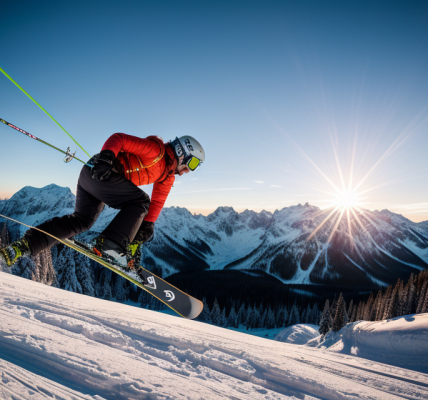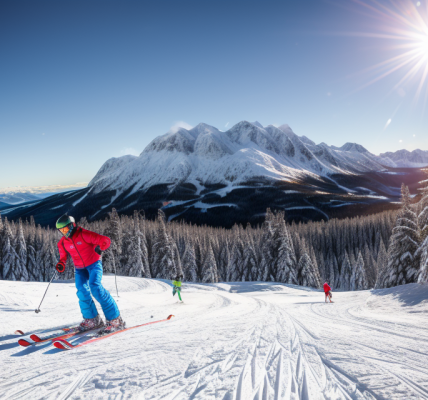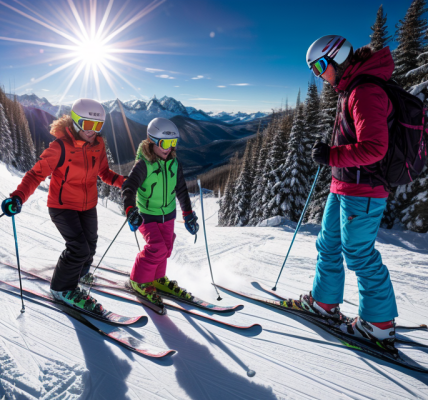Are you looking to hit the slopes but don’t have a lot of time to spare? Many people wonder if it’s possible to learn to ski in just 2 days. While it may seem like a daunting task, with the right approach and plenty of practice, it is definitely possible. In this article, we’ll explore the ins and outs of learning to ski in a short amount of time, including what to expect and how to make the most of your time on the mountain. So, buckle up and get ready to hit the slopes like a pro in no time!
It is possible to learn to ski in just 2 days, but it will likely be a challenging and exhausting experience. Skiing is a complex sport that requires a combination of physical and mental skills, and it can take time to develop proficiency. However, with dedicated instruction and practice, it is possible to learn the basics of skiing in a short period of time. It’s important to note that skiing can be dangerous, and proper safety precautions and instruction should always be prioritized. Additionally, continued practice and instruction will be necessary to improve and build upon the skills learned in just 2 days.
What to Expect When Learning to Ski in 2 Days
Day 1: Basic Techniques and Safety Instructions
On the first day of learning to ski, you can expect to spend the majority of the time learning the fundamental techniques and safety instructions that will form the foundation of your skiing skills.
Understanding the Fundamentals of Skiing
Skiing is a sport that involves gliding down a snow-covered slope using long, flat boards called skis. The fundamental principles of skiing involve balancing, steering, and stopping. Understanding these basics is crucial to your success on the slopes.
Getting Familiar with the Equipment
Before you start skiing, it’s important to get familiar with the equipment you’ll be using. This includes putting on your ski boots, adjusting your bindings, and adjusting your poles. You’ll also learn how to carry your skis and poles while walking on the snow.
Basic Techniques: Snowplough, Edging, and Turning
Once you’ve gotten familiar with your equipment, it’s time to start learning the basic techniques of skiing. This includes the snowplough, edging, and turning. The snowplough is a technique used to slow down and stop, while edging is used to turn and control your speed. Turning is a combination of both techniques and involves shifting your weight and using your edges to make smooth turns.
Safety Instructions and Guidelines
Safety is a top priority when skiing, and on day one, you’ll learn the guidelines and rules to ensure a safe and enjoyable experience on the slopes. This includes knowing when and how to use a ski lift, how to ski in control, and what to do in emergency situations. You’ll also learn about the importance of wearing a helmet and other safety gear.
Overall, day one of learning to ski is focused on teaching you the fundamental techniques and safety instructions that will help you progress and become a confident skier. With patience, practice, and guidance from an experienced instructor, you can achieve success on the slopes in just two days.
Day 2: Building Confidence and Practice
On the second day of learning to ski, the focus shifts towards building confidence and practicing various skiing techniques. Here are some of the key activities that you can expect to be part of your skiing lessons on Day 2:
- Refining skiing techniques: On the first day of skiing, you would have learned the basic skiing techniques such as how to stand, how to slide, and how to turn. On Day 2, you will build on these techniques and refine them to improve your overall skiing ability. This will involve practicing different skiing styles, such as the parallel turn and the stem christie, which are essential for making your way down the mountain.
- Building confidence on intermediate slopes: As you become more comfortable with the basic skiing techniques, you will move on to intermediate slopes, which are slightly steeper than the beginner slopes. The aim of this exercise is to build your confidence and help you get used to skiing on steeper terrain. Your instructor will provide guidance and support to help you feel more comfortable and confident as you ski down the mountain.
- Practicing turning, stopping, and slowing down: Skiing is not just about going down the mountain as fast as possible. It also involves learning how to control your speed and direction by turning, stopping, and slowing down. On Day 2, you will practice these skills to help you become a more proficient skier. Your instructor will provide guidance on how to use your ski poles to help you slow down and how to turn in different directions.
- Overcoming fear and developing muscle memory: Skiing can be a daunting activity, especially for beginners. On Day 2, you will work on overcoming any fears you may have and developing muscle memory to help you become a more confident skier. This will involve practicing different skiing techniques and repeating them until they become second nature to you. Your instructor will also provide encouragement and support to help you feel more confident as you ski down the mountain.
Overall, Day 2 of learning to ski is all about building confidence and practicing various skiing techniques to help you become a more proficient skier. By the end of the day, you will have developed a solid foundation of skiing skills that will help you enjoy the rest of your skiing holiday.
The Benefits of Learning to Ski in 2 Days
Building Confidence and Skill Quickly
Accelerated Learning Curve
One of the primary benefits of learning to ski in just 2 days is the accelerated learning curve. Traditional ski lessons typically span over a period of weeks or even months, but by condensing the learning process into a shorter time frame, beginners can rapidly improve their skills and gain a better understanding of the sport. This intensive approach allows individuals to pick up essential techniques and build confidence more quickly, ultimately enabling them to enjoy their time on the slopes sooner.
Faster Progression and Improvement
By learning to ski in just 2 days, individuals can experience a faster progression and improvement in their abilities. This condensed learning experience allows for more focused attention on essential skiing techniques, enabling beginners to quickly grasp the fundamentals and build upon them. As a result, they can move from basic to advanced skiing maneuvers at a quicker pace, allowing them to enjoy a wider range of skiing experiences in a shorter amount of time.
Gaining a Sense of Accomplishment
Learning to ski in just 2 days can also provide a sense of accomplishment that might not be experienced through a longer, more traditional learning process. By rapidly progressing through the early stages of skiing and tackling more challenging slopes, beginners can experience a sense of pride and achievement that comes with mastering a new skill. This boost in confidence can translate to other areas of their lives, providing a lasting sense of empowerment and fulfillment.
Enjoying the Slopes Sooner
- Shorter learning curve: One of the most significant advantages of learning to ski in just two days is the shorter learning curve. This means that you can quickly pick up the basics of skiing and start enjoying the slopes sooner than if you were to take a longer course. With intensive instruction and practice, you can acquire the necessary skills to ski in a shorter amount of time, allowing you to hit the slopes with confidence and enjoy the thrill of skiing.
- Quick adaptation to skiing: Another benefit of learning to ski in two days is the quick adaptation to skiing. When you take an intensive course, you are able to focus on your skiing technique without distractions or interruptions. This allows you to quickly adapt to the sport and develop good habits from the start. You will learn how to balance, turn, and stop efficiently, which will enable you to progress more quickly and enjoy the slopes sooner.
- Less time spent on basic techniques: Learning to ski in just two days also means that you will spend less time on basic techniques. With intensive instruction, you can bypass the beginner stages and move straight to more advanced techniques. This will enable you to progress more quickly and spend less time on the basics, allowing you to enjoy the slopes sooner. Additionally, by learning more advanced techniques, you will be able to challenge yourself and enjoy the thrill of skiing on more difficult terrain.
Exploring the Mountains Safely
One of the main benefits of learning to ski in just 2 days is the ability to explore the mountains safely. By learning the safety guidelines and protocols, individuals can build confidence in various skiing conditions and ski with more freedom and independence.
Learning Safety Guidelines and Protocols
Learning safety guidelines and protocols is a crucial aspect of skiing, as it can help prevent accidents and injuries. Ski schools typically provide comprehensive safety instruction, covering topics such as how to fall properly, how to use ski lifts, and how to avoid collisions. Additionally, skiers are taught to always ski within their ability level and to avoid skiing in areas that are marked as closed or hazardous.
Building Confidence in Various Skiing Conditions
By learning to ski in just 2 days, individuals can build confidence in various skiing conditions. This includes skiing in different types of terrain, such as groomed runs, powder, and ice. With proper instruction, individuals can learn how to adjust their skiing style to match the conditions, which can help them ski more safely and effectively.
Skiing with More Freedom and Independence
Finally, learning to ski in just 2 days can give individuals the freedom and independence to explore the mountains on their own. With proper instruction and practice, individuals can learn how to navigate the mountain on their own, without the need for constant supervision. This can be a liberating experience, allowing individuals to fully enjoy the beauty and thrill of the mountains.
Challenges of Learning to Ski in 2 Days
Physical Strain and Fatigue
Learning to ski in just two days can be a daunting task, especially when considering the physical strain and fatigue that come with it. Skiing is a physically demanding sport that requires a great deal of endurance and stamina. For beginners, it can be challenging to keep up with the physical demands of skiing, which can lead to fatigue and exhaustion.
Building endurance and stamina is crucial when learning to ski in a short amount of time. This requires a consistent and focused effort to improve physical fitness. It is important to note that skiing can be physically taxing, especially when attempting to master new skills and techniques. As a result, beginners may experience muscle soreness and fatigue, which can affect their ability to continue skiing for extended periods.
Additionally, physical limitations can also play a role in the physical strain and fatigue associated with learning to ski in just two days. For example, individuals with certain medical conditions or injuries may have limitations that prevent them from skiing at their full potential. In these cases, it may be necessary to adjust skiing techniques or take breaks more frequently to avoid exacerbating any existing physical limitations.
In conclusion, physical strain and fatigue are significant challenges when learning to ski in just two days. It is important to build endurance and stamina, while also being mindful of physical limitations. By addressing these challenges, beginners can increase their chances of success and enjoy a fulfilling skiing experience.
Mental and Emotional Struggles
Learning to ski in just two days is an ambitious goal, and it comes with its own set of challenges. One of the biggest challenges is the mental and emotional struggles that one may encounter while trying to master this sport. Here are some of the ways in which skiing can be mentally and emotionally taxing:
- Fear and anxiety while skiing: Skiing can be a dangerous sport, and it is normal to feel a bit of fear and anxiety when trying something new. However, excessive fear and anxiety can be debilitating and make it difficult to focus on the task at hand. This fear can lead to hesitation, which can then lead to accidents and injuries.
- Mental toughness and perseverance: Skiing requires a lot of mental toughness and perseverance. It is not uncommon to fall or make mistakes, and it takes a lot of mental fortitude to get back up and try again. This can be especially challenging when the slopes are crowded or when the conditions are difficult.
- Coping with setbacks and failures: Skiing is a sport that requires a lot of practice and repetition. It is inevitable that one will encounter setbacks and failures along the way. Learning how to cope with these setbacks and failures is an important part of the learning process. It is important to remember that failure is a natural part of the learning process and that each failure is an opportunity to learn and improve.
In conclusion, learning to ski in just two days is a challenging goal, and it is important to be aware of the mental and emotional struggles that one may encounter along the way. With the right mindset and approach, however, it is possible to overcome these challenges and make significant progress in a short amount of time.
Time and Resources Constraints
One of the main challenges of learning to ski in just 2 days is the limited time available for learning. With only a short period of time to dedicate to skiing, it can be difficult to make significant progress and build the necessary skills and confidence to ski proficiently. Additionally, accessing quality instruction and resources can also be a challenge when trying to learn to ski in such a short amount of time. Ski schools and instructors may be booked solid, or the resources available may not be sufficient to meet the needs of a beginner.
Another challenge is balancing skiing with other activities. When learning to ski in just 2 days, it can be difficult to find the time to practice and build on the skills learned during the lessons. It can be a juggling act to balance skiing with other activities, such as sightseeing or socializing, and make the most of the limited time available.
Tips for Learning to Ski in 2 Days
Focus on the Fundamentals
Learning to ski in just two days may seem like a daunting task, but with the right approach, it is possible. Here are some tips to help you make the most of your limited time on the slopes:
- Prioritize basic techniques and safety: It’s important to remember that skiing can be a dangerous sport, so safety should always be your top priority. Make sure you understand how to ski in control and how to stop, and always wear a helmet.
- Mastering the snowplough and edging: The snowplough is a fundamental skiing technique that helps you control your speed and direction. To master this technique, start by making small turns with your skis pointing in different directions. Edging is another important technique that involves shifting your weight from one ski to the other to maintain balance and control. Practice this technique by making slow, controlled turns on the slope.
- Practicing good posture and balance: Good posture and balance are essential for successful skiing. Keep your weight forward and your knees bent, and avoid leaning back or leaning too far forward. Practice standing up straight and shifting your weight from one ski to the other to maintain balance.
By focusing on these fundamentals, you can make significant progress in just two days and set yourself up for a successful skiing experience.
Take Regular Breaks
Taking regular breaks is an essential part of learning to ski in just 2 days. Here are some tips to help you take the right breaks at the right times:
Listening to your body
Listening to your body is crucial when taking breaks while skiing. If you feel tired, hungry, or thirsty, it’s essential to take a break and address those needs. If you’re feeling pain or discomfort in your muscles, it’s important to take a break and stretch or rest. Taking breaks when you need them will help you avoid fatigue and injury, and ensure that you can continue to learn and improve your skiing skills.
Staying hydrated and energized
Staying hydrated and energized is critical when skiing, especially if you’re trying to learn in just 2 days. Make sure to bring plenty of water and snacks with you to the slopes, and take breaks to refuel and rehydrate. Dehydration can cause fatigue, dizziness, and headaches, which can all negatively impact your skiing performance. Eating and drinking regularly will help you maintain your energy levels and stay focused on your skiing goals.
Resting and recovering between runs
Resting and recovering between runs is essential for maximizing your learning and improvement while skiing. Take a few minutes between runs to rest and recover, stretch your muscles, and prepare for the next run. This will help you avoid fatigue and injury, and ensure that you can continue to learn and improve your skiing skills. Additionally, taking breaks between runs will give you a chance to review your performance, make adjustments to your technique, and mentally prepare for the next run.
Seek Quality Instruction
When it comes to learning to ski in just 2 days, seeking quality instruction is crucial. Here are some tips to help you find the right instructor and get the most out of your lessons:
Finding a certified ski instructor
Look for an instructor who is certified by a reputable organization such as the Professional Ski Instructors of America (PSIA) or the Canadian Ski Instructors’ Alliance (CSIA). Certified instructors have undergone rigorous training and testing and are knowledgeable about different skiing techniques and safety protocols. They can also adapt their teaching style to your individual needs and abilities.
Receiving personalized feedback and guidance
A good instructor will provide personalized feedback and guidance tailored to your specific skiing style and goals. They will help you identify areas where you need improvement and provide you with the tools and techniques to make those improvements. This type of personalized instruction can help you progress quickly and avoid bad habits that can hinder your progress.
Seeking advice from experienced skiers
While certified instructors are the best option for formal lessons, you can also seek advice from experienced skiers who can offer tips and guidance on the slopes. Look for skiers who are skilled and experienced in the areas where you want to improve, such as mogul skiing or powder skiing. They can offer valuable insights and help you develop your skills in specific areas.
Overall, seeking quality instruction is essential when learning to ski in just 2 days. A certified instructor can provide personalized feedback and guidance, while experienced skiers can offer tips and advice on the slopes. With the right instruction, you can make significant progress in a short amount of time and enjoy your time on the slopes.
Embrace the Journey
Embracing the journey when learning to ski in just 2 days is essential to make the most of your time and achieve your goals. Here are some tips to help you embrace the journey:
Enjoying the process of learning
Learning to ski can be a challenging and rewarding experience. It is important to enjoy the process of learning and not just focus on the end result. This means embracing the journey and not getting discouraged by falls or mistakes. By enjoying the process, you will be more likely to stay motivated and focused throughout your lessons.
Being patient and persistent
Learning to ski in just 2 days requires patience and persistence. It is important to understand that progress may not come quickly, and that it is normal to experience setbacks along the way. By being patient and persistent, you will be able to overcome obstacles and continue to improve your skills.
Celebrating small achievements and progress
Celebrating small achievements and progress is a crucial part of embracing the journey when learning to ski. This means acknowledging and celebrating every small success, such as making a turn or stopping correctly. By celebrating these achievements, you will be able to maintain a positive attitude and stay motivated throughout your lessons. Additionally, recognizing your progress will help you see how far you have come and inspire you to continue improving.
FAQs
1. What is the minimum amount of time needed to learn how to ski?
While it’s certainly possible to learn the basics of skiing in a short amount of time, two days may not be enough to become a proficient skier. Skiing is a sport that requires both physical and mental skill, and it typically takes time and practice to develop these skills. However, some people may have a natural talent for skiing and may be able to pick up the basics more quickly than others.
2. How much time should I plan for learning to ski?
If you’re completely new to skiing, it’s recommended to plan at least a few days to a week to learn the basics. This will give you enough time to become comfortable with the equipment, learn the proper techniques, and build your strength and endurance. If you’re planning a ski vacation, consider scheduling an extra day or two to take lessons and get a feel for the sport before venturing out on your own.
3. What should I look for in a ski lesson?
If you’re serious about learning to ski, it’s highly recommended to take lessons from a qualified instructor. Look for an instructor who is certified by a reputable organization such as the Professional Ski Instructors of America (PSIA) or the Canadian Ski Coaches Federation (CSCF). In addition, look for an instructor who is patient, supportive, and able to adapt their teaching style to your individual needs.
4. What should I expect on my first day of ski lessons?
On your first day of ski lessons, you can expect to spend some time getting fitted for equipment and learning about safety procedures. Your instructor will likely start by teaching you the basics of balance and posture, and then gradually introduce you to skiing techniques such as turning and stopping. Depending on your level of comfort and confidence, your instructor may take you down a beginner slope or a gentle terrain.
5. How important is practice when learning to ski?
Practice is essential when learning to ski. It’s important to take lessons regularly and spend time on the slopes practicing the techniques you’ve learned. The more you practice, the more comfortable and confident you’ll become, and the faster you’ll progress. It’s also important to be patient with yourself and to remember that everyone learns at their own pace. Skiing is a challenging sport, but with dedication and practice, anyone can become a proficient skier.




